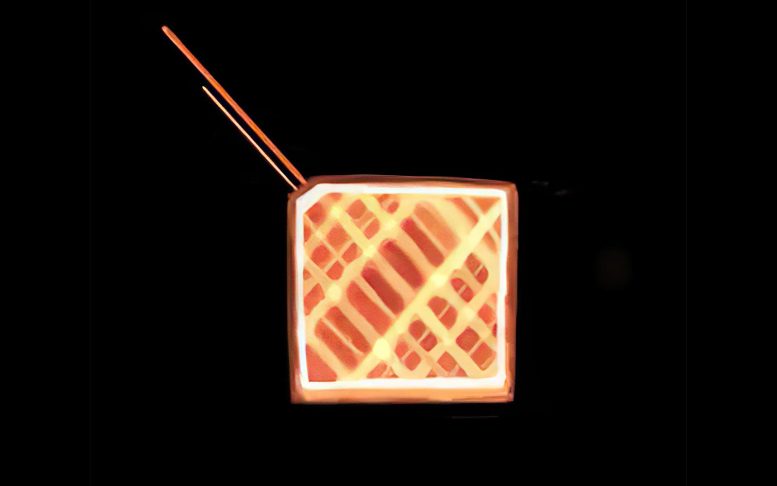
Artist’s rendering illustrates the nitrogen-vacancy diamond sensor the Beck group will develop. The internal grid lines represent the path of laser light within the diamond—the incoming beam (thicker red line) is repeatedly reflected within the diamond sensor until it encounters the cut corner where it emerges (the thinner red line). Image by Yasmine Steele for Illinois Physics. Credit: The Grainger College of Engineering at the University of Illinois Urbana-Champaign
The University of Illinois Urbana-Champaign’s nuclear physics group is participating in the nEDM experiment at Oak Ridge National Laboratory, aiming to measure the neutron’s electric dipole moment to constrain theories in particle physics. The researchers aim to construct sensors for the nEDM experiment and explore their potential applications in quantum information science. The unique quantum properties of nitrogen-vacancy diamond make it a promising candidate for quantum sensing and quantum memory.
The nuclear physics group at the University of Illinois Urbana-Champaign is looking for evidence of new physics in neutrons, electrically neutral particles that hold atomic nuclei together with an interaction called the strong force. Faculty and researchers are participating in the nEDM experiment at Oak Ridge National Laboratory which will measure the neutron’s electric dipole moment, a property that allows neutrons to interact with electric fields despite their neutrality. A precise measurement will constrain theories extending the current standard model of particle physics. To achieve this, the researchers must accurately measure subtle changes in very strong electric fields.
Professor of Physics Douglas Beck has been awarded a grant from the Department of Energy to develop sensors based on nitrogen-vacancy diamond, a material whose quantum properties at low temperatures make it unusually sensitive to electric fields. His research group has shown that the material can measure strong electric fields, and the award will allow the researchers to construct sensors ready to use in the nEDM experiment. In addition, the material’s quantum properties make it a promising candidate for quantum information science. The researchers will also explore these potential applications.
Beck explained that chemically added nitrogen vacancy, or NV, impurities give diamond unusual electric field sensitivity. “These impurities are regions with an extra nitrogen atom and a hole [or vacancy] where carbon atoms normally would be,” he said. “When the material is cooled to less than 20 degrees above absolute zero, the impurities form a quantum system that responds to electric fields. This is quite an unusual characteristic because not many systems respond to electric fields, and that makes NV diamond special.”
The NV system can be made even more sensitive when it is prepared in a particular quantum state. Instead of letting the system stay in its lowest energy state after they cool it, the researchers form a quantum superposition of the lowest and next-lowest energy states called a dark state, so named because it does not interact with light. “In a sense, the name is meant to suggest that it’s immune to interactions with the environment,” Beck said. “Because it is long lived, it has a very sharply defined energy that very accurately tells us how big the electric field is.”
Beck’s group has demonstrated that this phenomenon enables NV diamond to measure strong electric fields, and the award will allow the researchers to develop reliable, robust sensors based on it. This will involve packaging sensors into units that readily connect with the lasers used to control them and minimize the effects of background noise. They are also investigating a quantum technique called dynamical decoupling that would allow them to effectively reverse the effects of experimental imperfections, according to Beck. This would make the already-precise electric field measurements even more accurate.
Another goal of the research is to explore proposals for using NV diamond in quantum information science. The dark state’s long lifetime and resilience against environmental noise make it a promising platform for quantum sensing and quantum memory. Many such applications depend on placing quantum systems in squeezed states that possess the minimum uncertainty allowed by the Heisenberg principle. There have been several proposals for creating squeezed states in NV diamond, and Beck’s group will survey their feasibilities.
This work will be supported with $650,000 over three years awarded by the Quantum Horizons initiative in the Department of Energy’s Nuclear Physics program.


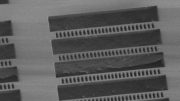

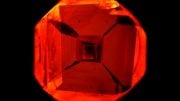
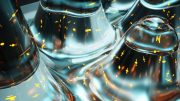
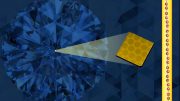
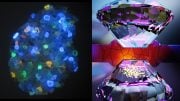
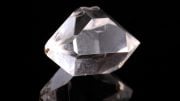
Be the first to comment on "A Cutting-Edge Diamond Sensor for Neutron Experiments and Quantum Information Science"